-
Posts
11,151 -
Joined
Content Type
Profiles
Forums
Store
Help Articles
Posts posted by slkinsey
-
-
Interesting. I'm a little surprised at Sapphire being described as a "more assertive spirit for cocktails" -- especially alongside Junìpero, which really is quite assertive. I have it on good authority that Sapphire was created specifically to be the "vodka drinker's gin" with a less assertive flavor profile than most gins around at the time.
Trillium, the comparative gin tasting sounds very interesting. I'd be especially interested to do a tasting first at room temperature and then later at a cold temperature to see what the difference would be.
-
One main difference, to my taste, between Rose's and anything with fresh lime juice is that the fresh citruc juice is much more acidic. Like most people here, I use fresh in any cocktail other than a gin gimlet. I'm inclined to use fresh lime juice in gimlet-like cocktails, but they don't strike me as gimlets then so much as gimlet-inspired drinks. So, I guess that means that I usually drink gimlet knockoffs (I like gin, simple syrup, fresh lime juice and a whisper of Ricard).
-
I think it would be a mistake to assume that the various non-alcoholic agents in alcoholic beverages could not possibly affect the body and/or nervous system so as to produce a modulated intoxication experience. That said, I think it would be a much, much larger mistake to underestimate the power of psychological suggestion in creating such effects (I think many of us are familiar with the phenomenon whereby someone gets "high" smoking something they think is marijuana).
If one were able to create an alcoholic beverage of equivalent proof that looked/smelled/tasted exactly like tequila, champagne, rum, whatever, but which was made entirely of substances (other than alcohol of course) that are known to have no psychoactive properties, I think it is highly likely that people who were inclined to experience special intoxication effects associated with those beverages would, in fact, experience the same effects with the facsimile.
This is not to suggest ay that such experiences are not legitimate. An experienced pheomenon is an experienced phenomenon, and if tequilla imparts a characteristic intoxication for that person then so be it. One should not automatically assume that it is due to a chemical effect, is all. For example, inexpensive tequila is often made with only around 51% agave. Would one experience the same special intoxication effect drinking 51% agave tequila as when drinking 100% agave tequilla? Or would the 100% agave tequila be twice as potent with respect to the special effect?
-
Thanks for the write up. Yours is the first description that really puts me in mind of a "Vongerichten-ified Luger."
Oh... one thing: whatever you do, don't drink a coke while you're eating the crackling cherry tart.

-
Re the history of the gimlet: If we suppose it is true that the Gimlet came from the Royal Navy, then it is almost certainly the case that it was made with lime cordial rather than fresh limes. From the Mott's web site, we have:
Lauchlin Rose (1829-1885) a descendent of a prominent family of Scottish ship builders, founded L. Rose & Company in Leith, Edinburgh in 1865. Describing himself as a "lime and lemon juice merchant," he combined a keen business sense with his knowledge of the sea. Scurvy, caused by a deficiency of vitamin C, had been the scourge of sailors since the early days of sailing ships. To prevent "this most terrible of the diseases of maritime life," a supply of lime or lemon juice preserved with 15% of rum, generally was boarded for long voyages. In 1867, Lauchlin developed and patented a process that effectively prevented fermentation and preserved fruit juice without alcohol. The same year, the Merchant Shipping Act was passed, whereby all vessels, Royal Navy and Merchant, were required to carry lime juice for a daily ration to ships' company. It was this enactment that resulted in British sailors being called "limeys" and brought about a sales volume boost for this new L. Rose & Company business. From Cape Town in Singapore, from Bombay to Belize, Rose's literally sailed the seven seas.I'm not sure when the gimlet was formulated -- and, indeed, it is likely impossible to know -- but given its long association with Rose's it strikes me as highly probable that it was among the original ingredients. Despite his preference for Rose's, by the way, the recipe on Drinkboy's own web site calls for Rose's.
-
Sam, that was a typo, right? 2 hours; not 20?



Er... yes, it was a typo. Fixed above.
20 hours... mmmm, "Cup O' Tannin"
-
So... what is the coolest, funkyest, potentially illegal-est cheese I can get at Fairway?
Or perhaps to put it another way, if we came to Fairway and said, "show me a cheese that 's really going to blow me away" what would it be? And why?
-
I found Mario Batali's post here interesting with respect to using a cork to cook 'puss:
we put the octo in a big pot with a couple of chilis, 2 cloves garlic and a cork, and no water... and pop it into a 350 oven for a hour covered and then remove it and let it cool... we then portion it, chill it and then grill it to order on the hot spot of the grillThe emphasis is mine. Now, obviously a guy like Mario isn't going to use a cork in his restaurant unless he feels like it is doing some good. Yet, for the life of me, I can't imagine how it could effect the texture of the octopus without water.
-
I used tea-infused rum to make a Southern style "Sweet Tea Shooter" for my pig pickin' last year. I think there's a ton of potential using tea infusions. I actually infused for a couple of days, though (in a mason jar, of course!
 ).
). That must have been really strongly tea-flavored, no? Or was it fairly heavily diluted?
I was amazed at how strongly the Earl Grey tea infused the Tanqueray in only 2 hours. Then again, the Earl Grey MarTEAni is not particularly diluted.
You're right that there are a lot of possibilities. I'm trying to think of a way to use a lapsang souchong tea infusion in a drink. Lapsang souchong is a souchong tea which has been withered over pine or cedar fires, pan-fried, rolled and oxidised before being fully dried in bamboo baskets over burning pine. It's quite smokey in flavor.
Edited to fix: 2 hour infusion, not 20 (d'oh!).
-
Lobster tomalley, eschewed by many, loved by the chosen few...
what's that? (sorry, stupid question)
The tamale is the liver of the lobster.
I used to eat this, and enjoyed it. Unfortunately, lobsters are like little concentration machines for heavy metals, PCBs, etc. -- and just about all of that is in the tomalley. So, sadly, I don't eat it any longer.
Oh, just for general informational puposes:
Tamale = filled masa dough steamed in a corn husk
Tomalley = lobster liver
-
Damn it, Sam....you were in and I missed you?? I took a week off, and am now only working Thur-Fri-Sat's. Please ring me and let me know when you're coming in.... I would love to meet you!
I'll probably be there on Friday.
 Let me know how it worked out for you. Hope you enjoyed!
Let me know how it worked out for you. Hope you enjoyed!For us, it worked great. Very easy to do, although I might have infused the Earl Grey just a little longer than the specified 2 hours to get the same taste I had at Bemelman's. This, I'm sure, is just a factor of the brand of Earl Grey tea (I used a loose tea I got at Fairway). Still, it's a simple drink to make and it really works -- especially for summer.
-
("Poeler" is I believe another way of describing what we would call braising)
Poeler means to sear in a pan. A sauté pan in French is called a poele.
Actually, un poêle means "a stove" (aka "oven"). Un poêlon means "a casserole." Une poêle à frire means "frying pan." Une poêle à sauter means "a sauté pan." Etc.
My understanging of poêler poêlé and poêlage is that they translate roughly as "to stove (something)," "stoved" and "stoveing" (or "to pan (something), "panned" and "panning"). I have commonly understood poêler and poêlage to mean cooking something very slowly in fat and a moderate amount of liquid in a tightly covered casserole in a stove. On the other hand poêlé seems to mean "pan-fried" in some uses. I suppose it depends on whether one is making a verb of stove or pan.
I've never heard poêle used to mean "sauté pan" specifically, as opposed to just being a general-purpose word for "pan." AFAIK, a sauté pan is most commonly called a sauteuse.
-
My *real* job is keeping slkinsey busy.
Unfortunately, you've run out of ways to do that in this topic area.
1. Caffè espresso dates from the early 20th century.
2. By the early 20th century, espresso did not mean "pressed out."
3. By the early 20th century, espresso did mean "expressly for you" and it did have connotations of speed
1 + 2 + 3 = caffè espresso means "coffee made expressly for someone" and has connotations of being made quickly
1 + 2 + 3 != caffè espresso means pressed out coffee
There's really nothing more to say about it.
-
Please note for the record that I was NOT there last night.
 :sad: (bittersweet face)
:sad: (bittersweet face) I know. I broke our solemn vow. Our next time to Franny's is on me.
-
Okay, guys. I am going to step in here and moderate for the last time. If you want to argue about things which do not have fumdamentally to do with the restaurant Pure Food & Wine, you have two choices: 1) you can start a new thread, or 2) I can delete your post. I'm sure we'd all be much happier with the first choice.
For the record, it is quite common and it has been quite common for quite a long time in the culinary word to use naming conventions for dishes which evoke the original but do not reproduce the original. This is how we get things called "sea urchin cappuccino" and "salmon chops" and "zucchini spaghetti" and "monkfish tournedo" and "duck bacon" and "tuna pastrami" and, yes, eggless soufflé and beet tartare. This is not news, it is not unique to the raw food movement, and it is not something we should be taking about in this thread.
We have here a very interesting chef who "cooks" at Raw Food & Wine, who is part of the raw food movement, and who has been kindly disposed towards sharing some insight into this movement with us. Let us avail themselves of this resource rather than bickering about the definition of "soufflé" and "tartare."
-
Outstanding! I gotta go.
Dude. That's what I'm telling you! Just make sure you let me know the next time you're coming to town.
-
Oh! All of this Fernet!
Branca!
Menta!
I remember seeing a bottle of Fernet Menta somewhere on my travels, can't remember where though and I didn't taste it.

Must. Obtain. A. Bottle.
Interesting that you can't find it there. I've always thought it was very commonly found. Bummer. Anyway, no reason to limit yourself to just Fernet Branca and Brancamenta. The Fratelli Branca Distillerie Milan makes some other stuff too... Stravecchio Branca sounds extremely interesting. There's also the whole Carpano family, also made by the Fratelli Branca: Punt e Mes, Classico, Bianco, and Antica Formula. They even make a Chianti Classico Villa Branca.
A very interesting "Stinger" could be made with Stravecchio Branca and Brancamenta.
-
For me this was a real chalenge. It's eggplant fritto. I hate eggplant. I mean, hate eggplant. Eventually my companions shamed me into taking one for the team and trying one. You know what? It was really, really good.
I like eggplant. I like fried eggplant. This picture alone makes me pretty sure I want to try this place at some point. Soon.
You'd better go soon. Because there's no guarantee it's going to be on the menu in a few weeks.
-
Went to Franny's with some friends last PM, a few of whom might chime in with their impressions. The place continues to impress, and improve. This time I brought along my camera so I could take a few of my trademark terrible-quality amateur phographs and hopefully give those who haven't made the journey an impression of what its like. So...

Franny's is located along a bustling section of Flatbush Avenue, just a few blocks away from the Bergen Street 2/3 station. They have an almost aggressively unassuming storefront, such that no signage whatsoever is displayed when the security gate is down.

Here's a closer look. You can see just at the top there a blank spot where the signage for the previous occupants must have been. Although Franny's is easy to miss (one of our party walked right by it and didn't notice it was there -- and he was looking for it), it certainly doesn't seem to be affecting their business one iota. Indeed, tables were already somewhat scarce by the time we arrived at 6:30, whereas it was mostly empty at this time on our first visit. I chatted with owner/chef/pizzaiolo Andrew Feinberg, and he allowed that they have been getting just about as much business as they can possibly handle. Oh well... they can sleep later, right?

As before, we were greeted by owner/FOH manager Francine Stephens. Although I had only been there once before, she recognized me and we were greeted warmly. How do they do that? This is always such a great touch, and is one of the things that makes me eager to return to places like Franny's and Landmarc. It makes me feel good that we can have an outlet like eGullet to promote places like these that are doing it right.
Here are some pictures of the oven:
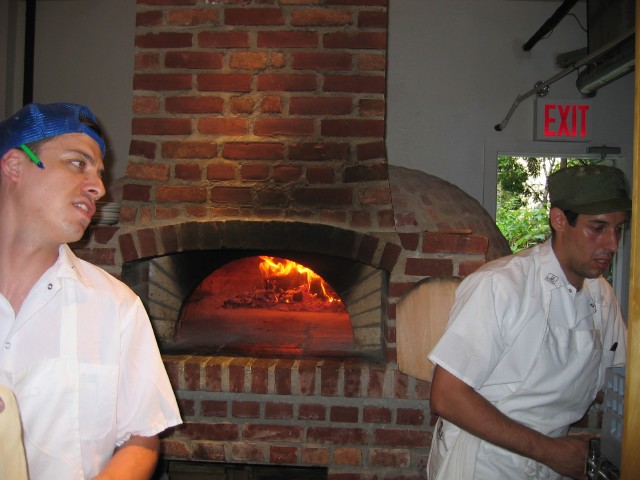
The guy with the pen stuck in his hat is Andrew.

This side view gives some sense of the scale of the oven. It's relatively small but, as I think this shows, extremely massive. It was interesting to hang out there for a few minutes and watch them work the oven. It is constantly being maintained, with new wood being added, the fire adjusted, ashes swept out, etc. -- all while a constant stream of pizza moves in, around and out. I also got a few minutes to chat with Andrew before things started getting crazy. Interestingly, one of the first things he asked was whether I'd been to Pizzeria Bianco in Arizona. Neither of us has been to this mecca of American pizza making, but we both feel the call to make a pilgrimage. Luckikly, bergerka's family is in Phoenix and I'l definitely be finding some excuse to go out there for a visit (after the summer!).
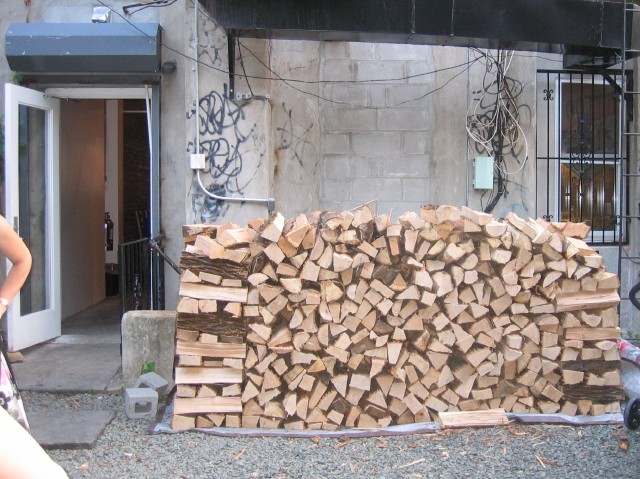
As you may imagine, this all takes a fair amount of wood. I wonder how long this lasts?
Okay, on to the food...
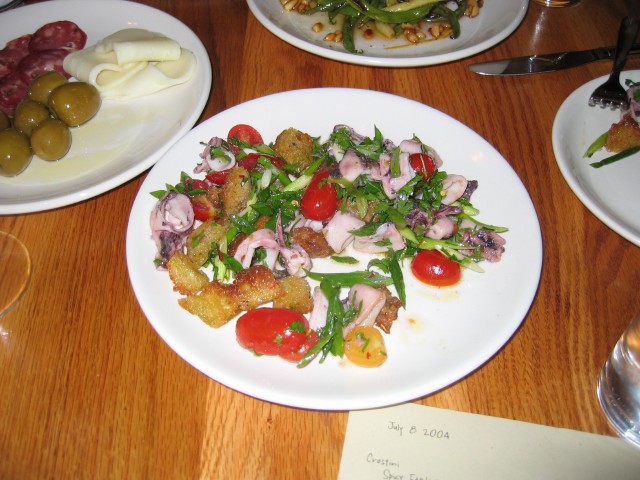
Here is the squid appetizer I mentioned above. It's the same, and yet different, which is the cool thing about a place that changes the menu according to what foods are at peak and what the local farmers are able to bring them. Many restaurants would have found a way to continue serving white beans with the squid. But that's not what they're getting in right now, so this time it was squid, scallions, sungold tomatoes, chilis, soft croutons, etc. Just this litte change in one ingredient metamorphosed it from a dish that was largely soft with earthy undertones to one that is a bright, sharp and crunchy -- and yet the same.
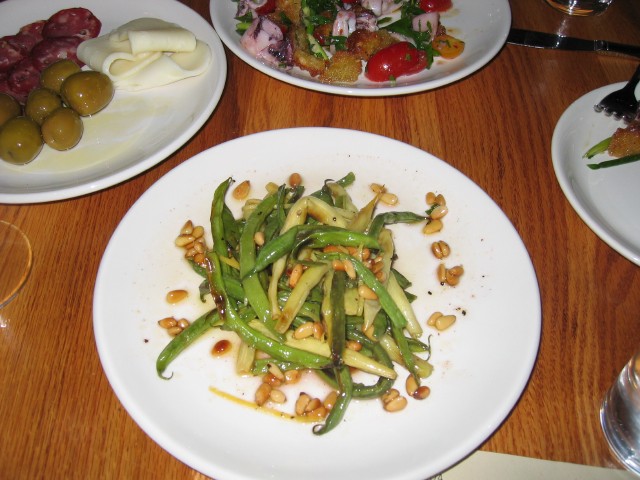
Another appetizer that was similar to one we had before was this plate of green beans with pine nuts, mint and lemon. Snap peas are over now, and so it's on to green beans. As with the snap pea dish, when you have ingredients this pristine, there really isn't a whole lot you should do with it. The pine nuts added a nice counterpoint to the brightness of the lemon and mint.
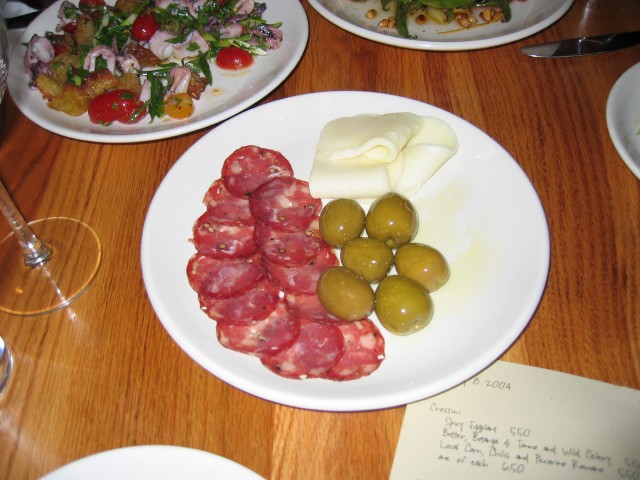
Here's a plate of house-cured sopressata with Marzolino and Sicilian olives. Marzolino is kind of like a sheep milk mozzarella -- really nice. Tthe sopressata didn't taste quite as funky as before, but I had already had some strong flavors in my mouth and it may have obscured some of the flavors.

Now begins an interesting part of the meal. The part I like to call "I really don't like this, but I am going to try it anyway... d'oh! this is really good." This one is a perfect example. Several of us "don't like beets." Nevertheless, we all liked this plate of beets with anchovy and egg very much. There are beets, and there are beets. As I explained, there are a lot of things that one may not like in their usual form, but it's a whole different ballgame when you're getting a peak product that someone just pulled out of the ground (the ground of the Farm at Miller's Crossing in Claverack, New York in this case). The saline anchovies, the bland eggs and the al dente, sweet-but-not-too-sweet beets were a very nice combination.
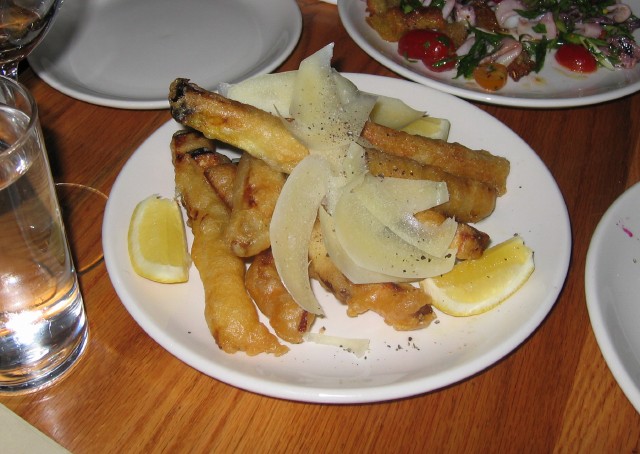
For me this was a real chalenge. It's eggplant fritto. I hate eggplant. I mean, hate eggplant. Eventually my companions shamed me into taking one for the team and trying one. You know what? It was really, really good. Slender sticks of eggplant with a light crisp coating. Not bitter. Not mushy. Really nice. I will now declare eggplant "good" as long as I can eat Kernan Family Farm eggplant prepared just this way in Franny's.

On to the main event...
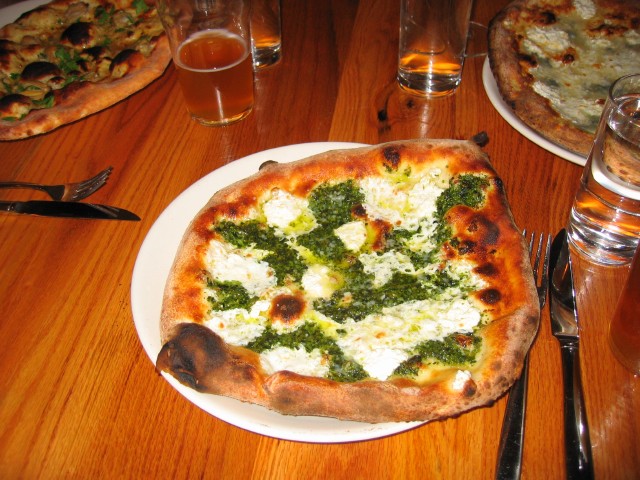
Basil pesto and ricotta. They used just the right amount of garlic in this pesto, so it doesn't take over the whole pizza. They used green garlic before (presumably for its mildness). I don't know if it's still green garlic season, whether they use some other mild form of garlic or whether they simply just use less. Anyway, it was nice to have something with pesto where other flavors besides raw garlic could be tasted.
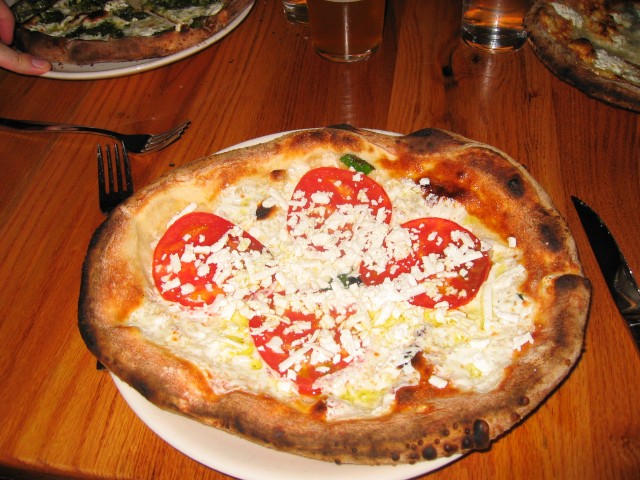
Fresh tomato and ricotta salata. The ricotta is grated onto the pizza when it comes out of the oven, where it melts on the warm crust. Speaking of the crust, check out that caramelization!
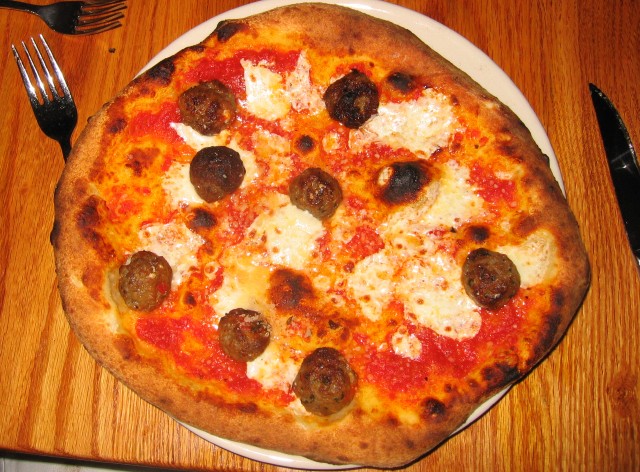
Tomato, mozzarella and meatballs. This is the only tomato sauce/mozzarella pizza I've had at Franny's. We liked it a lot. I especially like the way the ingredients are distributed on the crust: some places have both, some have just tomato, some have just mozzarela, some have neither. I also thought it was fun to use whole little meatballs, which sometimes escape and roll around a little, instead of flat slices of large meatballs. That said, I can see how some eaters might be underwhelmed by this pizza. It's not an intensely flavored , herby sauce and great stringy blobs of mozzarella. As with all their pizze, the toppings are relaively understated and clearly subordinate to the primacy of the crust. This is not to say that the other way can't be great too (I love DiFara as much as the next guy). But it is a totally different paradigm, and some people are unable or unwilling to break out of theirs (e.g., Adam Heimlich in his NY Press review).
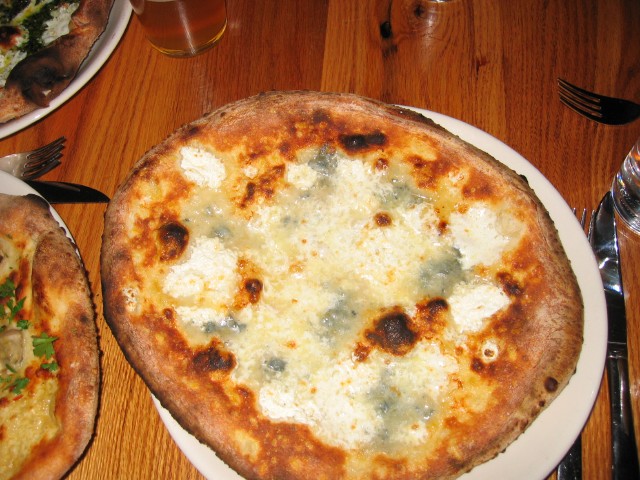
Quatro formaggio (sic. -- should be "quattro formaggi" -- misspelled Italian is somewhat common on the menu), including mozzarella, ricotta, gorgonzola and parmigiano reggiano). Um... what to say about this. The cheeses are all first rate. The pizza was delightful... and not too rich, which is often a problem with the four cheeses deal. Just the right amount of the moldy stuff, too, which is always my favorite.

This was the unequivocal star of the evening. Clams, chilis and parsley. Whoa. Nothing but fresh clams, shucked onto the crust and cooked in the heat of the oven, then a dusting of chili, a sprinkle of parsley and a drizzle of evoo. If I didn't know otherwise, I would have sworn the clams had been poached in butter. They were that buttery. According to Franny, they also do this with mussles. It just depends on what is looking best at the time. I hope they never take this off the menu, but then again, if they keep it on it will be a constant struggle to order anything else. Maybe that means I'd have to order two?! Oh well, there are worse things in life. This pizza, to me, says everything there is to say about how just a few ingredients, all at their peak and treated simply, can create something extraordinary.

Here's a look at the bottom of the crust. Not exactly a char like they get in the NYC old school places. Char, to me, means just a little bit burnt. The crust at Franny's, on the other hand, I would describe as "intensely and thoroughly caramelized." This trip solidified in my mind that Franny's is the overall best crust in the City. This is not to say that I don't still love and appreciate the NY char at Patsy's and Grimaldi's, etc. But Franny's is, IMO, doing something more profound with their crust.
We had dessert as well. Perhaps someone else will have something to say about that. I will say, however, that one extra summer bonus at Franny's is dessert out in the garden:
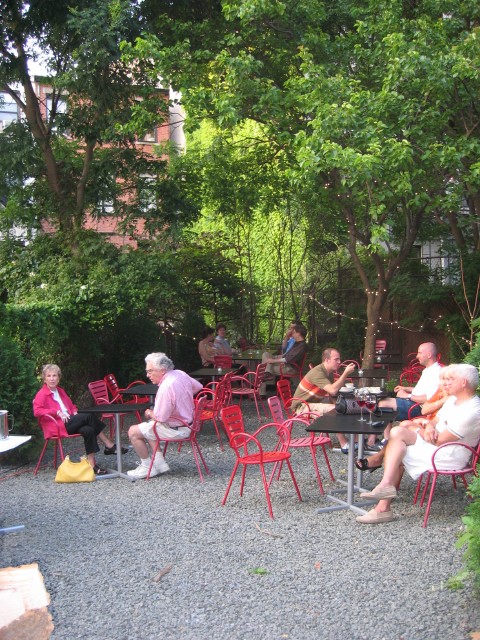
-
Had a Fernet Branca and Coke last night at Franny's. Sounds terrible. Is actually really good. Who knew? Will be interested to try it at home with Branca Menta.
-
As I stated earlier, after a fair amount of study of the topic (it's what I do for a living), to the best of my knowledge, the first use of "caffe espresso" as a phrase was in booth advertising at the 1906 International Trade Fair in Milan at the Bezzera exhibit where they offered caffe espresso made from their Ideale machine. Historical records indicated that Luigi Bezzera termed the drink "caffe expres" in all of the 1901 product and marketing materials. Given this, we can probably say that the odds are good that the earliest date for the use of "caffee espresso" in popular vernacular lies between 1901 and 1906 -- but certainly no later than 1906.
Right. I was only offering the 1945 date (which, as carswell points out, is really the date it entered the English vernacular) as a further indication of its 20th century provenance. That we can relatively conclusively date it to the early 20th century further bolsters my argument that espresso signifies not only "made expressly for someone" but also has connotations of speed, as this meaning was well established by the early 20th century.
Your information, for me, seals the deal against the notion that espresso means "pressed out coffee."
-
I realize that I have been remiss in not posting more substantially to this thread before now.
New York Burger Co. is an interesting place. I'm not sure exactly what I was expecting. One thing I really appreciated is that they don't hit you over the head with the "natural, wholesome food" thing that figured somewhat more prominently in their PR materials. As I have said elsewhere in these forums, for me, any restaurant's food needs to stand on its own. One shouldn't have to buy into the philosophy -- be it related to health, politics, whatever -- in order to appreciate the food. Rather, one should be able to appreciate the food simply as food. The philosophy is extra. This is something I mentioned to co-owner Madeline Poley, and she allowed as to how she felt the same. Fundamentally, New York Burger Co. is about being a middlebrow fast food burger place, producing a quality product at a reasonable price. I think they are successful in this goal, as this is exactly what NYBC feels like. It's only later, after you notice that the tomatoes and lettuce look especially fresh and there are a zillion different kinds of sauces, that it begins to sink in that they're doing something different.
What's nice from my perspective, though, is that they are still just trying to be a fast food place. After all, as Poley says, " if you're going to eat a burger, you might as well eat a good one." And why shouldn't you eat a burger? It's also good to see that unlike some other "next generation fast food" places (Better Burger comes to mind) they aren't trying to sell low fat burgers with soy "cheese" and "air crisped" French fries. Rather, they are doing everything the good old-fashioned way with 80/20 ground beef, real cheese and deep fried French fries. The difference is that the beef is Coleman natural beef (more on this later), the cheese is real cheese and the fries are cut fresh and deep fried in soybean oil. This is all good, in my opinion. Rather then reinventing the wheel or trying to make people accept odd alternatives or transmogrifications of the fast foods they love, serve them the food they want – just do it with ingredients that support what you are trying to do.
While we were there, I tried all three of their specialty burgers: the Chicago (bacon, cheddar, 1000 island), the Dallas (grilled onions, Monterrey Jack, BBQ sauce) and the Seatle (grilled portobello mushrooms, grilled onion, NYBC's "burger sauce" ). All were very good, and given the fact that philosophy-driven restaurants are often more expensive, it was nice to see that their offerings are priced competitively for the neighborhood. That said, NYBC is not offering a burger-connoisseur's ultimate hamburger. Despite the fact that they are using better quality beef, it's not the case that an NYBC burger stands above the competition like a Peter Luger porterhouse stands above the competition. I found that NYBC's burgers tasted right around as god as the (surprisingly excellent) burgers I get at Scotty's Diner around the corner from my day job. Considering that they are right around the same price, this is perhaps to be expected. I will say, however, that if NYBC were in the neighborhood, I'd be more likely to give them my business due to their ingredient sourcing.
All this is to say that New York Burger Co. isn't quite a "destination" burger place. . . yet. They're still getting their legs underneath them, and I think there are some relatively minor adjustments they could make that would propel them into that status (if, indeed, this is something to which they aspire). As Ellen mentions above, their meat is ground fine by Coleman and shipped to NYBC in cryovac-ed "pillows." At the store, uniform patties are formed (it looks like they must use some kind of mold) and the raw patties are stored for some period of time before being cooked. I think we all agreed that they would have benefited from a coarser grind which, in my experience, provides a "beefier" flavor and is more interesting to the tooth. I was also a little disappointed to learn that the meat was not ground on-premises. Some time ago, Fat Guy and I did a series of burger experiments using different cuts of beef, etc. Of all the differences we noticed, the one variable that had the largest impact on flavor and overall quality was time after grinding. There was simply no comparison between fresh ground and not fresh ground, and we eventually found ourselves recoiling from the flavor of the not fresh ground beef. This is undoubtedly a function of the oxidation that occurs when grinding exposes a vastly greater surface area to the air. Coleman mitigates this effect somewhat by packing their ground beef in vacuum, but I'd still love to taste a Coleman beef burger with the beef ground in-house fresh that day. A more "hand packed" texture would be appreciated too.
That said, it's an awful lot to ask for when you can get a burger, fries and a soda for less than 8 bucks! As I said before, I think they are highly successful at what they are trying to be: a middlebrow neighborhood fast food burger place that just so happens to be using quality, natural ingredients. I think they will he a big success, and there should be more places like it.
Another major point of interest was that we got to hang out with Mel Coleman, Jr., the Chairman of Coleman Natural Meats. Coleman supplies NYBC with their beef, and Coleman Natural Meats is the pioneer in the natural meat movement/industry. There is a lot more to be said about Mel and about Coleman Natural Meats, probably in another thread. Mel himself is exactly what one would expect in a beef man from Colorado, and yet also exactly what one would not expect. The expected part came packaged in ostrich-skin cowboy boots and a hat, and clearly had a thorough knowledge of animal husbandry and hands-on experience at every level of the industry. I guess I was also expecting some pithy stories about artificial insemination and branding yearlings to go along with the outfit. I'm sure there's plenty of that to be had, but Mel also pulled out his pen and treated us to a detailed explanation of the extremely complex economics involved in selling the beef from a 1,200 pound cow. Once Fat Guy finishes working up the graphs and flow charts and we both go back to school for a few more years of mathematics, we'll make a post on that. Really, though, Mel Coleman is a great guy, Coleman appears to be a wonderful business. We will be trying to get to know both better and undoubtedly will have much, much more to post about Coleman and Mel in the future.
-
It really depends what we're arguing about here. So a "hamburger" originally meant "ground meat like they serve in Hamburg, Germany" but that's not really what it means in modern American usage. Whatever a caffe espresso originally meant, it now means "made at the moment you order it," according to Lo Zing. Agreed. Or maybe not agreed. Shall we delve into signifiers and signifieds?
Note that there is no history of the word in Lo Zing, so there's no way to determine whether its current usage is a back-formation from the phrase "caffe espresso," whatever its original derivation. For example, "turkey burger" is a back-formation unrelated to the German root-word "burg." Without the history of the word its impossible to tell. Care for some ground meat like they serve in Turkeyburg, Germany?
Perhaps I don't understand where you're coming from, unless you are arguing in favor of my point now. This fork of the discussion came from a poster who furthered the definition from the OED that "caffè espresso" means "pressed out coffee." My contention is that this definition is not correct, and that it does not make sense to derrive the current meaning from its Latin origins, as the OED does.
What I get out of what you are saying here is that it is ridiculous and inappropriate to trace the etymology of "turkey burger" all the way back to its German origin in order to understand its meaning today -- just like it is ridiculous and inappropriate to trace the etymology of the Italian word "espresso" all the way back 1,000+ years to a Latin verb in order to understand its meaning today. If this is what you're saying, then we are in agreement. What do these things tell us? If I were to approach the "turkey burger" question as you and the OED have approached the "espresso" question, I should conclude the following: turkey burger comes from hamburger and hamburger comes from Hamburg, Germany. Therefore, "turkey burger" means "turkey prepared in the style of Hamburg, Germany." This is, of course, ridiculous. The meaning of "turkey burger" has nothing whatsoever to do with Hamburg, Germany. Why? Because it is based on a meaning of "burger" that has nothing whatsoever to do with Hamburg, Germany.
Now, from a purely historical and etymological standpoint, it is most likely true that "turkey burger" can be traced back to Hamburg, Germany. Unfortunately, this doesn't really help us underestand the meaning of "turkey burger." The same thing can be said for the Italian word espresso. It is the past participle of esprimere, which evolved out of a Latin verb exprimere which had the meaning "to press out." So far so good. But, just as "Hamburg, Germany" doesn't tell us much about the meaning of "turkey burger," neither does exprimere tell us much about the meaning of espresso -- except, of course, from a purely historical standpoint.
So, where does this leave us in terms of understanding the meaning of espresso? According to the OED, since the Italian word espresso can be linked back a few thousand years to the Latin verb exprimere, and since the Latin verb exprimere means "to press out," the Italian word espresso means "coffee that is pressed out." This is more or less analogous to an Italian dictionary saying that "turkey burger" means "turkey served in the style of Hamburg, Germany."
It just seems nonsensical to attempt to frame one's understanding of a word that describes a 20th century product (albeit with technological origins as far back as 1821), according to a Latin verb and/or the meaning of an Italian verb which was archaic by that time. Similarly, if I we could say "the turkey burger was invented in 1973" I would look to meanings of "burger" from around 1973 or later upon which to base my understanding of "turkey burger."
That's all I'm really saying here. "Espresso" is the p.p. of esprimere. Esprimere hasn't meant "pressed out" for a long time, and it didn't have that meaning for at least a hundred years before the invention and popularization of the coffee product known as caffè espresso. Therefore, it strikes me that, despite what the OED and other English language dictionaries suggest, there is no way espresso has that meaning.
Another question to be answered is when it started to be called caffè espresso. Although you assert that the first European patent for a steam-pressure coffee machines was granted 1821, there is no reason to suppose that the word caffè espresso dates from this time. FWIW, most people date the invention of "espresso" from Bezzera's 1901 patent, and indeed his was the first machine to use the force of steam to directly press water through the coffee grounds. Prior to that time, the other machines used pressure to force the water some distance above the coffee grounds, after which the force of gravity carried the water through the grounds. Mostly these machines were to be found at expositions and fairs and the like. The consumption of espresso as a popular phenomenon dates from the 20th century, with the rollout of the Pavoni and Victoria Arduino machines, etc. and it strikes me as most likely that the usage of caffè espresso dates from this time or later. This guy here dates it from 1945 in his English etymology dictionary (altnough he also furthers the OED's definition), which would put it after the 1938 Cremonesi piston pump and just prior to Gaggia's rollout of commercial piston machines (i.e., the birth of modern espresso).
Whichever date one prefers, both 1821 and 1901 put espresso many years removed from the meaning "pressed out." Both, on the other hand, are well within the years in which is had the meaning "declared of manifested explicitly." 1901 puts it well within the years in which it had an additional meaning of being fast. This brings me right back to what I said earlier: caffè espresso means either "coffee made quickly," or "coffee made at the moment for someone" -- or, most likely, both. Although, perhaps I should put the two meanings in reverse order so as to give precedence to the meaning of longer standing: caffè espresso means either "coffee made explicitly (at the moment) for someone," or "coffee made quickly" -- or, most likely, both.
-
A few things here:
OED (2nd Ed) gives 'expresso,' pronounced with an "ex," as a variant of 'espresso,' pronounced with an "ess." . . . As for etymology, OED concurs with other English sources . . .With all due respect, I still cannot figure out why we should care in the least what an English language dictionary has to say about the etymology of an Italian language word. The OED is a great resource for English. For Italian, why not turn to the "OED of Italian" -- Lo Zingarelli?
Clearly, one can't just look at 21st century usage of an Italian word to determine the derivation of a word coined more than a hundred years ago. In fact, looking at the English usage of the word 'express' (assuming, in the absence of other information, that italian usage was roughly parallel) shows that the time of first usage in Italian would apparently be of key interest.As shown below, espresso has been around in use as the past participle of esprimere since 1292. THe primary meaning, dating from that time, is "declared of manifested explicitly" as in "I have manifested this tiny little cup of coffee explicitly for you." Note that the use of the verb esprimere to signify "pressing out" is considered archaic, which meaning has long been taken (since the 16th century) by the verb spremere (past part. spremuto).
Lo Zingarelli says:esprimere o *espremere, *ispremere, *sprimere [vc. dotta, lat. exprimere 'premere (premere) per far uscire (ex-)'; sec XIII] A. v. tr. (pass. rem. io esprèssi, tu esprimésti; part. pass. esprèsso) 1 Manifestare con atti e parole [to manifest with actions and words] . . . 2 Tradurre in espressione artistica [to translate in artistic expression] . . . 3 Generare, produrre [to generate, to produce] . . . 4 *Spremere. [to squeeze] 5 (fig) *Trarre fuori [to draw out] B v. intr. pron [esprimersi]
espresso (1) o *ispresso, *spresso [av. 1292] A part. pass di esprimere; anche agg. 1 Dichiarato o manifestato esplicitamente [Declared or manifested explicitly]
* = parola o accenzione arcaica [archaic word or meaning]
The first European patent for a steam-pressure coffee machines was granted 1821. If the phrase originates from this date, it almost certainly refers to pressed out (due to pressure - again, with the Latin root premere), as such machines made coffee by the pot.If we're talking about something that dates from 1821, then why are we trying to trace its name back to a language that had been long dead by 1821, and overlooking contemporary meanings in the appropriate language? Again, per Lo Zingarelli, it would seem that the use of espresso to describe coffee dates from the mid-19th century:
espresso (2) [ingl. express dal fr. exprès 'espresso'; 1853] A Celere, rapido [quick, rapid] | Detto di cibo o bevanda preparati sul momento per chi li richiede [said of food or drink prepared at the moment for he/she who requests it]: piatto e.; spaghetti espressi; caffè e. [express dish, express spaghetti, express coffee] B in funzione di agg. inv. Detto di corrispondenza che viene recapitata con maggiore celerità e che richiede un'affrancatura di maggiore importo rispetto a quella ordinaria [said of correspondence that comes delivered with blah blah blah] C s.m. 1 (ellit.) [elliptical] Caffè espresso: chiedere, bere un e. [to ask (for), drink an espresso]. . .It seems fairly clear to me, as I said before, that caffè espresso means either "coffee made quickly," or "coffee made at the moment for someone" -- or, most likely, both.



What's Behind that $15 Martini?
in Spirits & Cocktails
Posted
Interesting article. I wonder how much the rise in price also has to do with the fact that cocktails are, on average, quite a bit larger than they used to be.
I found this passage interesting as well: